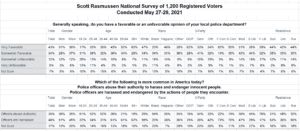Forty-eight percent (48%) of voters believe police officers are harassed and endangered by the actions of people they encounter more than they abuse their authority. A Scott Rasmussen national survey found that 35% believe it is more common for police officers to abuse their authority to harass and endanger innocent people.
There is a massive partisan divide on this question. Seventy-five percent (75%) of Republicans believe police are more likely to be harassed and endangered. Fifty-four percent (54%) of Democrats believe police are more likely to abuse their authority.
Independent voters are more evenly divided. Forty-two percent (42%) believe police are more likely to be endangered while 32% take the opposite view.
There is also a significant racial divide: 55% of White voters believe police are more likely to be harassed and endangered. However, 55% of Hispanic voters and 54% of White voters think police officers are more likely to harass and endanger innocent people.
The survey also found that 77% of voters have a favorable opinion of their local police department. Just 17% have an unfavorable view. A majority of every measured demographic group holds a favorable opinion of their local police.
SIGN UP to receive Scott’s free email newsletter.
CHECK OUT Scott’s latest polls.
Note: Neither Scott Rasmussen, ScottRasmussen.com, nor RMG Research, Inc. have any affiliation with Rasmussen Reports. While Scott Rasmussen founded that firm, he left more than seven years ago and has had no involvement since that time.
Methodology
The survey of 1,200 Registered Voters was conducted by Scott Rasmussen using a mixed mode approach from May 27-29, 2021. Field work for the survey was conducted by RMG Research, Inc. Most respondents were contacted online or via text while 170 were contacted using automated phone polling techniques. Online respondents were selected from a list of Registered Voters and through a process of Random Digital Engagement. Certain quotas were applied, and the sample was lightly weighted by geography, gender, age, race, education, internet usage, and political party to reasonably reflect the nation’s population of Registered Voters. Other variables were reviewed to ensure that the final sample is representative of that population.



